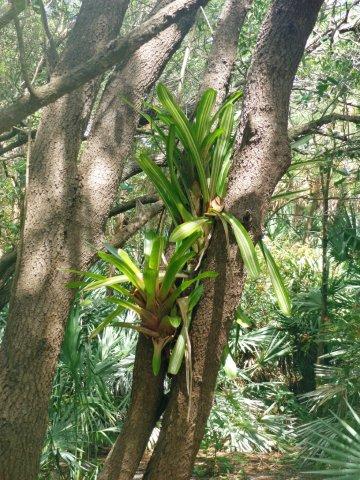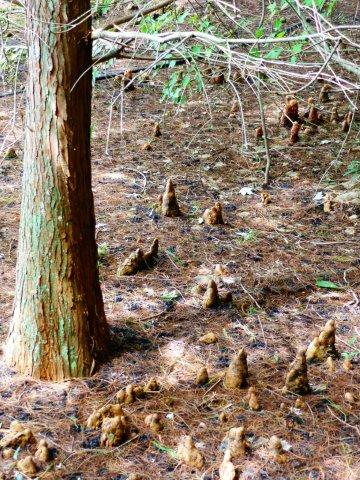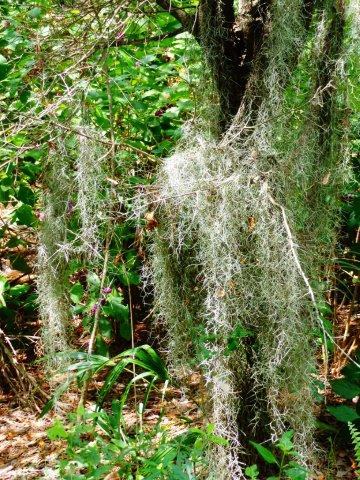QR Zones of Green Cay Wetlands Boardwalk
Back to Introduction

 Follow this link to see a video presentation of this zone!
Follow this link to see a video presentation of this zone!
This zone is mostly made up of cypress trees - a very flood tolerant tree that can grow in areas frequently covered by water. Cypress swamps are forested wetlands dominated by cypress trees and are located in still or slow moving water. Cypress can live for hundreds of years. They are characterized by "knees" that protrude above the ground and needles that fall off in the winter. The function of cypress knees is not completely understood, but they are generally seen on trees growing in swamps. It is thought they may help in oxygenation to the tree's roots or assist in anchoring the tree in the soft, muddy soil. Cypress swamps provide a habitat for many wildlife species including some that are rare and endangered, such as Limpkins and Wood Storks.
Trees: Red Maple, Pond Apple, Pop Ash, Dahoon Holly, Pond Cypress, Bald Cypress, Virginia Willow.
Understory: Giant Leather fern, Climbing Aster, Common Buttonbush, Sawgrass, Swamp-lily, Flatsedge, Royal Fern, Shield Fern, Green Arrow Arum, Lizard’s Tail, Wild Coffee, Spanish Moss, Tree Frogs.
Animals: Various Songbirds, Warblers, Snakes, Lizards, Tree Frogs.

BALD CYPRESS TREE - Often found in swampy settings, particularly in the eastern half of the United States. The tree grows along the banks of creeks, rivers and streams that have slow-moving water and is abundant in the Deep South, according to the University of Florida. The bald cypress is also a habitat in and of itself, providing a home for animals in its trunk and branches and food for them in the form of its seeds. The bald cypress tree can survive for centuries. Growing slowly, the bald cypress will get taller and taller for roughly 200 years, reaching heights of up to 150 feet. The trees usually live for 600 years, though some specimens are said to have survived for more than 1,000 years. Midway through their lives, fungus often besets the bald cypress, beginning at the top of the tree and working its way down.

AIR PLANTS - Aerophytes, or Air Plants, are a type of epiphyte which are plants that grow harmlessly attached to a host plant. Instead of growing in soil, these plants obtain their moisture and nutrients from the air, rain, and sometimes from debris accumulating around it. Epiphytes differ from parasites in that epiphytes grow on other plants for physical support only and do not normally negatively affect the host. Closely related to pineapples, there are over 16 species of airplants native to Florida. 10 of those 16 species are considered threatened or endangered due to habitat loss, illegal collecting and invasive insects such as the Mexican bromeliad weevil.

DUCKWEED - Duckweed is a floating plant often forming large floating mats. It is an important high-protein food source for waterfowl and also is eaten by humans in some parts of Southeast Asia. As it contains more protein than soybeans, it is sometimes cited as a significant potential food source. The tiny plants provide cover for fry of many aquatic species. The plants are used as shelter by pond water species such as bullfrogs and bluegills. They also provide shade and, although frequently confused with them, can reduce certain light-generated growths of algae.

CYPRESS KNEES - A cypress knee is a term used in the biology of trees to describe the distinctive structures forming above the roots of a cypress tree. Their function is unknown, but they are generally seen on trees growing in swamps. Some scientists have thought they may help in oxygenation to the tree's roots or assist in anchoring the tree in the soft, muddy soil. Knees are woody projections sent above the normal water level, roughly vertically from the roots. One early assumption of their function was that they provided oxygen to the roots that grow in the low dissolved oxygen waters typical of a swamp. There is little actual evidence for this assertion; in fact, swamp-dwelling specimens whose knees are removed continue to thrive, and laboratory tests demonstrate that the knees are not effective at depleting oxygen in a sealed chamber. Another more likely function is that of structural support and stabilization.

SPANISH MOSS - Spanish moss is a native, perennial epiphytic herb. It is not Spanish, nor a moss, but a flowering plant. The slender, wiry, long, branching stems (reaching over 20ft) grow as suspended, bluish-gray streamers and garlands draping among tree branches and sometimes telephone lines and fences. The plant is not parasitic, as is often thought, but attaches itself to trees for support. The plant has no roots but derives its nutrients from rainfall, detritus and airborne dust. The stems and leaves are covered with overlapping silver-gray scales, which are important for absorbing water and trapping dust and nutrient particles. Spanish moss has figured largely for generations in North and South American folk medicine traditions as a treatment for a wide variety of medical problems; several of these problems --particularly diabetes and skin conditions -- are believed by many alternative medicine practitioners to be effectively treated by Spanish moss. However, these claims have not been backed by scientific evidence, and Spanish moss use is not advocated by the Food and Drug Administration.
Green Cay Nature Center and Wetlands is owned and operated by the
Palm Beach County Parks and Recreation Department and the
Water Utilities Department.